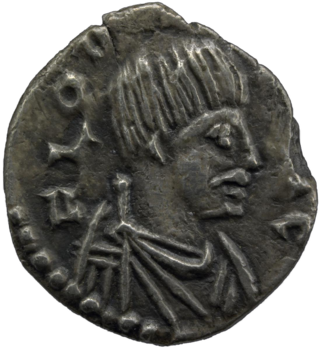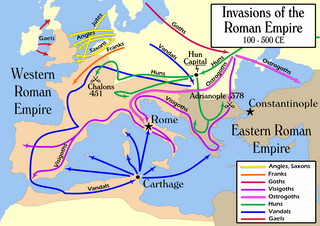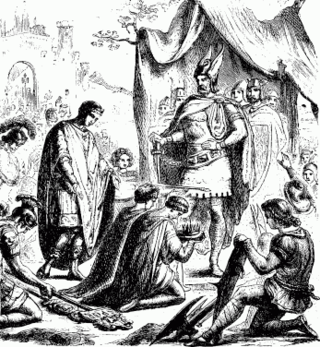The 480s decade ran from January 1, 480, to December 31, 489.

Odoacer, also spelled Odovacer or Odovacar, was a barbarian soldier and statesman from the Middle Danube who deposed the Western Roman child emperor Romulus Augustulus and became the ruler of Italy (476–493). Odoacer's overthrow of Romulus Augustulus is traditionally understood as marking the end of the Western Roman Empire.

The Heruli were one of the smaller Germanic peoples of Late Antiquity, known from records in the third to sixth centuries AD. The best recorded group of Heruli established a kingdom north of the Middle Danube, probably including the stretch where Vienna exists today. This kingdom was a neighbour to several other small and short-lived kingdoms in the late 5th century AD and early 6th century, including those of the Sciri, Rugii, Danubian Suebi, and Gepids. After the conquest of this Heruli kingdom by the Lombards in 508, splinter groups moved to Sweden, Ostrogothic Italy, and present-day Serbia, which was under Eastern Roman control.

The Quadi were a Germanic people during the Roman era, who were prominent in Greek and Roman records from about 20 AD to about 400 AD. By about 20 AD they had a kingdom centred in the area of present-day western Slovakia, north of the Roman border on the Danube river. After probably first settling near the Morava river the Quadi expanded their settlements eastwards over time until they also stretched into present day Hungary. This was part of the bigger region which had been partly vacated a generation earlier by the Celtic Boii. They were the easternmost of a series of four related Suebian kingdoms that established themselves near the river frontier after 9 BC, during a period of major Roman invasions into both western Germania to the northwest of it, and Pannonia to the south of it. The other three were the Hermunduri, Naristi, and the Quadi's powerful western neighbours the Marcomanni. Despite frequent difficulties with the Romans, the Quadi survived to become an important cultural bridge between the peoples of Germania to the north, the Roman Empire to the south, and the Sarmatian peoples who settled in the same period to their east in present day Hungary.

The Rugii, Rogi or Rugians, were one of the smaller Germanic peoples of Late Antiquity who are best known for their short-lived 5th-century kingdom upon the Roman frontier, near present-day Krems an der Donau in Austria. This kingdom, like those of the neighbouring Heruli and Sciri, first appears in records after the death of Attila in 453. The Rugii, Heruli, Sciri and others are believed to have moved into this region from distant homelands under pressure from the Huns, and become part of Attila's Hunnic empire which also moved and came to be based in this region. The Rugii were subsequently part of the alliance which defeated Attila's sons and the Ostrogoths at the Battle of Nedao in 454, giving their kingdom independence. In 469 they were part of a similar alliance who lost to the Ostrogoths at the Battle of Bolia, weakening their kingdom significantly.

The Migration Period, also known as the Barbarian Invasions, was a period in European history marked by large-scale migrations that saw the fall of the Western Roman Empire and subsequent settlement of its former territories by various tribes, and the establishment of the post-Roman kingdoms.

King of Italy was the title given to the ruler of the Kingdom of Italy after the fall of the Western Roman Empire. The first to take the title was Odoacer, a barbarian warlord, in the late 5th century, followed by the Ostrogothic kings up to the mid-6th century. With the Frankish conquest of Italy in the 8th century, the Carolingians assumed the title, which was maintained by subsequent Holy Roman Emperors throughout the Middle Ages. The last Emperor to claim the title was Charles V in the 16th century. During this period, the holders of the title were crowned with the Iron Crown of Lombardy.

In modern historiography, the Western Roman Empire was the western provinces of the Roman Empire, collectively, during any period in which they were administered separately from the eastern provinces by a separate, independent imperial court. Particularly during the period from AD 395 to 476, there were separate, coequal courts dividing the governance of the empire into the Western provinces and the Eastern provinces with a distinct imperial succession in the separate courts. The terms Western Roman Empire and Eastern Roman Empire were coined in modern times to describe political entities that were de facto independent; contemporary Romans did not consider the Empire to have been split into two empires but viewed it as a single polity governed by two imperial courts for administrative expediency. The Western Empire collapsed in 476, and the Western imperial court in Ravenna disappeared by AD 554, at the end of Justinian's Gothic War.

The Exarchate of Ravenna, also known as the Exarchate of Italy, was an administrative district of the Byzantine Empire comprising, between the 6th and 8th centuries, the territories under the jurisdiction of the exarch of Italy resident in Ravenna. The term is used in historiography in a double sense: "exarchate" in the strict sense denotes the territory under the direct jurisdiction of the exarch, i.e. the area of the capital Ravenna, but the term is mainly used to designate all the Byzantine territories in continental and peninsular Italy. According to the legal sources of the time, these territories constituted the so-called Provincia Italiae, on the basis of the fact that they too, until at least the end of the 7th century, fell under the jurisdiction of the exarch and were governed by duces or magistri militum under him.

Rodulf was king of the Heruli kingdom on the Middle Danube in the period around 500, and possibly of Scandinavian origin. He died in a battle in about 508, with the neighbouring Lombards, which led to the splitting up of the Heruli. He is probably the same Heruli king that Theoderic the Great wrote to in two surviving letters which do not mention his name, in one of which Theoderic "adopted" him with a gift of arms. Less certainly, many scholars also equate him to the King Rodulf that Jordanes mentions as having come from Scandinavia to Italy, to join Theoderic.

The Sciri, or Scirians, were a Germanic people. They are believed to have spoken an East Germanic language. Their name probably means "the pure ones".

Severinus of Noricum is a saint, known as the "Apostle to Noricum". It has been speculated that he was born in either Southern Italy or in the Roman province of Africa. Severinus himself refused to discuss his personal history before his appearance along the Danube in Noricum, after the death of Attila in 453. However, he did mention experiences with eastern desert monasticism, and his vita draws connections between Severinus and Saint Anthony of Lerins.

This is a chronology of warfare between the Romans and various Germanic peoples. The nature of these wars varied through time between Roman conquest, Germanic uprisings, later Germanic invasions of the Western Roman Empire that started in the late second century BC, and more. The series of conflicts was one factor which led to the ultimate downfall of the Western Roman Empire in particular and ancient Rome in general in 476.
Ovida or Odiva was a late Western Roman general and warlord of likely Gothic origin and the last Roman ruler of Dalmatia. Ovida initially served Julius Nepos, ruler of Roman Dalmatia and later western Roman emperor in Italy from 474 to 475. After being usurped in 475, Nepos continued to claim the imperial title in exile in Dalmatia, supported by the Eastern Roman Empire, but he was murdered by Ovida and another general, Viator, in 480. Upon his death, Ovida became the ruler of Dalmatia, a position he held until he was defeated and killed by Odoacer, the first barbarian King of Italy, in 481 or 482.

The Turcilingi were an obscure barbarian people, or possibly a clan or dynasty, who appear in historical sources relating to Middle Danubian peoples who were present in Italy during the reign of Romulus Augustulus (475–76). Their only known leader was Odoacer (Odovacar), but he was described as a ruler of several ethnic groups.

Odoacer's deposition of Romulus Augustus, occurring in 476 AD, was a coup that marked the end of the reign of the Western Roman Emperor last approved by the Western Roman Senate and the creation of the Kingdom of Italy, although Julius Nepos exercised control over Dalmatia until 480.
Flaccitheus was the founder of the Kingdom of the Rugii.
Feletheus was the king of the Rugii from 475 to 487.
Tufa was a Germanic warrior active in 5th century Italy.
Frideric was the leader of the Germanic Rugians from 487 to 492/493.













